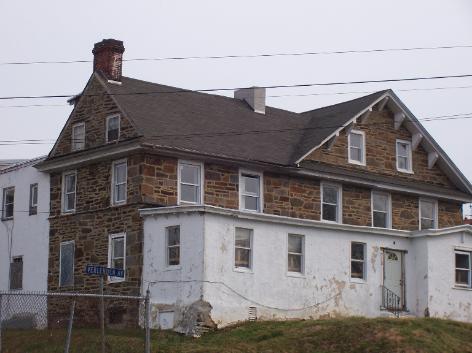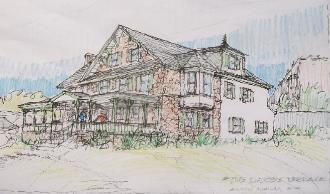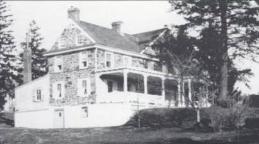
715 Darby Terrace, otherwise known as Woodmount, was part of the 320 acres (1/2 square mile)
purchased by William Wood from William Penn in 1683 (see below) and was a witness site to
Rochambeau's March as the army came down the hill into Darby on the way to the final battle of the
Revolutionary War at Yorktown, VA. Architect Al Holm of the Darby Historical Commission said
715 Darby Terrace is a "commanding presence...with sound construction and imaginative design,
readily convertible to a variety of uses at no great cost. When refurbished and appropriately
landscaped the property will be a source of civic pride and neighborhood delight.” (Full text)
purchased by William Wood from William Penn in 1683 (see below) and was a witness site to
Rochambeau's March as the army came down the hill into Darby on the way to the final battle of the
Revolutionary War at Yorktown, VA. Architect Al Holm of the Darby Historical Commission said
715 Darby Terrace is a "commanding presence...with sound construction and imaginative design,
readily convertible to a variety of uses at no great cost. When refurbished and appropriately
landscaped the property will be a source of civic pride and neighborhood delight.” (Full text)
From Ashmeads "History of Delaware County "
http://www.delcohistory.org/ashmead/ashmead_pg517.htm
"William Wood emigrated from Nottingham, England, with his wife and family, in 1683, and
settled at Darby, where he acquired three hundred and twenty acres, which plot included all the
land on which the original village of Darby stood, the tract reaching northward to
Friends' meeting-house lot and southward to the junction of Cobb's and Darby Creeks. On the latter
stream William Wood built the mills, or if he did not his son Joseph Wood did, to whom the property
descended in 1685, on the death of his father, William. In 1693, John Bethel took charge of these
mills,which he subsequently purchased, for June 7, 1695, Joseph Wood, in open court acknowledged
a deed for nine acres - the mill tract - to Bethel. The next year, Dec. 8, 1696, John Bethel sold to
Samuel Carpenter, the noted merchant of Philadelphia in those early days, a half-interest in several
tracts of land, one being nine acres on Darby Creek, "Upon which last-mentioned piece of land there
is three water grist-mills and a fulling mill lately erected." In the same deed it is stated that on the
same day of the date of the deed to Carpenter, Bethel had purchased from John Blunston "all
that millcat race or Trench digged in and through the said Blunston's land and meadow, from the
said Darby Creek toward the said mills." This mill-race to-day follows the course "digged" nearly
two centuries ago through Blunston's land. (As an aside, the mill race can still be traced from the site
of the 12th street (Supplee) dam.
http://www.delcohistory.org/ashmead/ashmead_pg517.htm
"William Wood emigrated from Nottingham, England, with his wife and family, in 1683, and
settled at Darby, where he acquired three hundred and twenty acres, which plot included all the
land on which the original village of Darby stood, the tract reaching northward to
Friends' meeting-house lot and southward to the junction of Cobb's and Darby Creeks. On the latter
stream William Wood built the mills, or if he did not his son Joseph Wood did, to whom the property
descended in 1685, on the death of his father, William. In 1693, John Bethel took charge of these
mills,which he subsequently purchased, for June 7, 1695, Joseph Wood, in open court acknowledged
a deed for nine acres - the mill tract - to Bethel. The next year, Dec. 8, 1696, John Bethel sold to
Samuel Carpenter, the noted merchant of Philadelphia in those early days, a half-interest in several
tracts of land, one being nine acres on Darby Creek, "Upon which last-mentioned piece of land there
is three water grist-mills and a fulling mill lately erected." In the same deed it is stated that on the
same day of the date of the deed to Carpenter, Bethel had purchased from John Blunston "all
that millcat race or Trench digged in and through the said Blunston's land and meadow, from the
said Darby Creek toward the said mills." This mill-race to-day follows the course "digged" nearly
two centuries ago through Blunston's land. (As an aside, the mill race can still be traced from the site
of the 12th street (Supplee) dam.





< "Trunnels" (pegs)
holding the massive
timbers together
holding the massive
timbers together
Poem- Vacant Lots of Darby

Help us turn this ^ to this >
